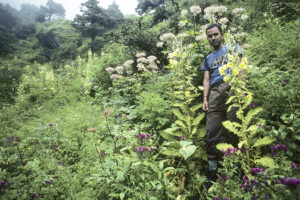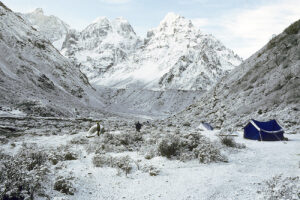Kaj Halberg - writer & photographer
Travels ‐ Landscapes ‐ Wildlife ‐ People
Plant geography and vegetation zones of the Himalaya
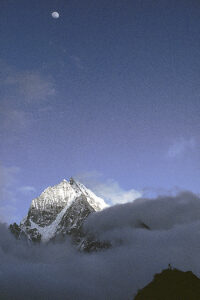
About 5 million years later, continental drift caused the smaller continent to be pushed beneath the larger continent. The Tethys Sea shrunk, as the continuous continental drift was pressing huge land masses upwards. This was the beginning of the process, which created the highest mountain range in the world: the Himalaya.
Most authorities consider Nanga Parbat, a mountain in northern Pakistan, as the westernmost peak in the Himalaya. Many others, however, also include the Karakoram Mountains further north, although, strictly speaking, they are not part of the Himalaya proper. The easternmost part of the range is c. 2,600 km to the south-east, in the northern tip of Myanmar.
In Sanskrit, himalaya means ’the abode of snow’ – a suitable name, as the 14 peaks on Earth, which exceed 8,000 m altitude, are found in this mountain range, including Sagarmatha (8850 m), in the West known as Mt. Everest, in Tibet as Chomolangma, K 2 (8611 m), in the West also called Godwin Austen, in Sinkiang Dapsang, Kangchendzonga (8586 m), Lhotse (8511 m), Makalu (8463 m), Cho Oyu (8201 m), Dhaulagiri (8167 m), Manaslu (8163 m), Nanga Parbat (8125 m), Annapurna I (8091 m), and Shishapangma (8013 m), also called Gosainthan.
The mountain folding is an ongoing process, and, parallel to the Himalaya proper, lower mountain ranges have been formed. The middle range, in Nepal called Mahabharat, reaches an altitude of c. 3,000 m, whereas the southern range, in India called Siwalik, and in Nepal Churia, reaches c. 1,800 m. The flat lowland at the foot of the mountains, which in many places is less than 100 m above sea level, is called Terai.
The rivers of the Asiatic Continent, which were originally running north-south into the Tethys Sea, managed to cut channels through the newly created land at about the same pace, as the land was rising.
Traditionally, the Kali Gandaki Valley, situated in central Nepal between the peaks of Annapurna I (8091 m) and Dhaulagiri (8167 m), is regarded as the deepest canyon in the world – although it is not nearly as dramatic as the Grand Canyon in the United States, or the Fish River Canyon in Namibia.
When these mountains were formed, many lakes were created, the major part of which have long since been drained by continuing erosion. One example is the Kathmandu Valley, which, until c. 40,000 years ago, was a huge lake. The majority of today’s lakes are reservoirs, and most of the natural lakes are rather small, some examples being Dal Lake in Kashmir, Hem Kund in Uttarakhand, and Lake Rara in western Nepal. As opposed to the Himalaya proper, the Tibetan Plateau has an abundance of natural lakes, big and small, most of which are more or less salty.

The Himalaya is home to an overwhelming abundance of plant species. In Nepal alone, c. 6,500 species of seed plants have been found, and the number in the entire mountain range exceeds 10,000. To this number, hundreds of species of ferns, clubmosses, mosses, and lichens must be added.
In his book Forests of Nepal, Stainton describes 35 different plant communities, which can be grouped into six altitudinal zones. As local conditions of the terrain have a huge influence on the micro-climate of a specific area, these zones often overlap several hundred metres in altitude. The most important factors, which affect distribution of plant species, are altitude, precipitation, latitude, sun exposure, soil composition, and, to a great extent, human influence on Nature.
Most of the plant species mentioned below are dealt with in detail on the pages Plants: Himalayan flora 1, 2, and 3.
Until around 1950, a deadly form of malaria was raging in the Terai and the lower foothills, causing this area to be sparsely populated. Since then, draining and spraying with pesticides have largely eliminated the disease, and the major part of the area has been converted into farmland. Today, the indigenous flora and fauna of this zone is almost exclusively restricted to nature reserves.
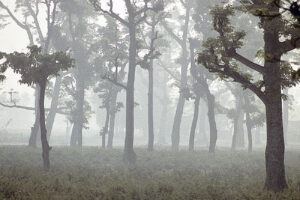
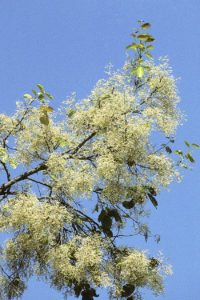
In the western part of the Himalaya, from the Indian State of Himachal Pradesh eastwards to central Nepal, the dominant tree species in the lower foothills is sal (see above), which, above c. 1,000 m, is replaced by the chir, or long-leaved, pine (Pinus roxburghii). Other characteristic species of this zone include a species of olive, Olea cuspidata, a camel’s-foot tree, Bauhinia variegata, a coral tree, Erythrina stricta, and Butea monosperma, the latter two belonging to the pea family (Fabaceae).
The eastern part of the mountains is far more humid than the western part. Dominant species include Schima wallichii of the tea family, two chestnut species, Castanopsis indica and C. tribuloides, both with edible fruits, Terminalia crenulata of the leadwood family, Lagerstroemia speciosa of the loosestrife family, a screw palm, Pandanus nepalensis, a date palm, Phoenix humilis, a cycad, Cycas pectinata, and tree ferns, such as Cyathea spinulosa.
Following the intensive malaria control, the major part of the foothills are today inhabited, and most of the forest has been cleared and converted into farmland. The remaining forest is widely utilized for timber, firewood, fodder, and grazing. In many places, plantations of important timber species, such as sal, chir pine, and Schima wallichii, have been established.
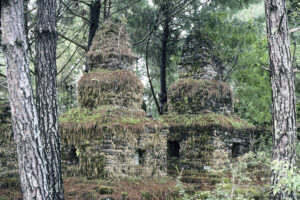
In the wetter part of the mountains, from central Nepal eastwards, the most common species in this zone are an oak, Quercus lamellosa (by some known as Cyclobalanopsis lamellosa), and blue pine (Pinus wallichiana). Other species include Lithocarpus pachyphylla of the beech family, the tall Rhododendron arboreum, a maple, Acer campbellii, ten species of magnolia, of which M. campbellii is the most common, three species of Deutzia, of the hydrangea family, several species of Prunus, and many others. The trees are often densely draped with epiphytes, especially lichens, ferns, mosses, begonias, and orchids of the genera Coelogyne and Dendrobium.
Further west, the climate is much drier, the vegetation being dominated by three oak species, Quercus semecarpifolia, Q. floribunda, and Q. incana, and others, including blue pine, Himalayan spruce (Picea smithiana), Himalayan cedar, or deodar (Cedrus deodara), Indian horse-chestnut (Aesculus indicus), common walnut (Juglans regia), maple species, and members of the laurel family, such as Machilus odoratissima. Today, this forest type is highly threatened, covering only about 55,000 km2.
The understorey and clearings are often covered in shrubs, including two beautiful members of the heath family, Pieris formosa and Gaultheria fragrantissima, various species of St. John’s wort (Hypericum), indigo plants, Indigofera, and brambles, Rubus, the latter genus comprising no less than c. 45 species.

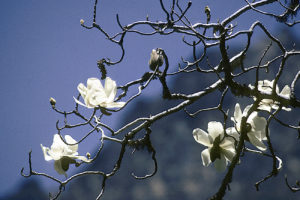
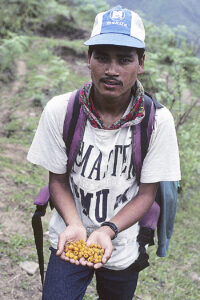
Rhododendron species, notably R. arboreum and R. barbatum, also form forests. During their flowering period, in March-April, large tracts of forest have a reddish or pinkish tinge from millions of rhododendron flowers. Incidentally, the former species is the national plant of Nepal, called lali guras.
In this zone, the forest floor is often covered in dense shrubs of various species of dwarf bamboo, especially of the genera Arundinaria and Thamnocalamus. Conspicuous shrubs include species of Viburnum and barberry (Berberis), and a beautiful, yellow-flowered bush of the pea family, Pipthanthus nipalenses. Due to their bizarre appearance, Arisaema species, of the arum family, stand out among the herbs. No less than c. 16 species of these remarkable plants can be encountered. Clusters of epiphytic orchids are often found on trunks of older trees, chiefly four species of Pleione.
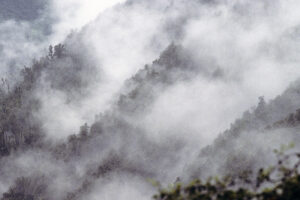
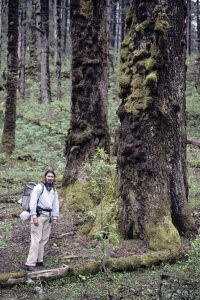
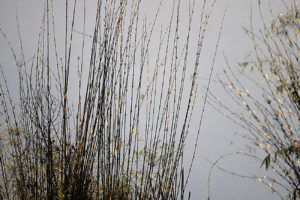
In drier areas, three species of juniper, Juniperus indica, J. recurva, and J. semiglobosa, form open forests. Shrubs like barberry, honeysuckle (Lonicera), and the fragrant Daphne bholua var. glacialis, grow here and there. Herbs include species of larkspur (Delphinium), primrose (Primula), saxifrage (Saxifraga), Bergenia, and various composites, including the beautiful genera Cremanthodium and Ligularia.
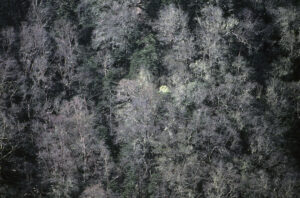
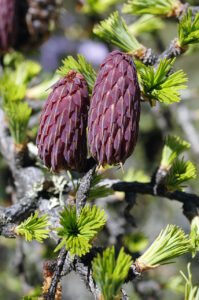
During the rainy season, between June and September, the alpine meadows display a wonderful selection of herbs, comprising species of primrose, cinquefoil (Potentilla), poppy (Meconopsis), larkspur, saxifrage, roseroot (Rhodiola), umbellifers, members of the pea family, composites like Aster, edelweiss (Leontopodium), and Saussurea and many others. Various members of the gentian family can be seen as late as November.
In snow-free areas above c. 5,500 m, the majority of plants are lichens. A few seed plants, however, are also able to survive the harsh conditions. The altitudinal record is held by a species of sandwort, Arenaria bryophylla, which was found on Mt. Everest in 1921, at an altitude of 6,180 m.

In the eastern part of the mountains, the monsoon begins in late May, in Nepal in mid-June, and in the far west, in northern Pakistan, not until early July. In the eastern part, the monsoon ends late September, whereas in Pakistan it ends as early as the beginning of this month. In the western part, however, quite a lot of precipitation falls in the winter, whereas rain at this time of the year is sparse in the eastern mountains.
In Darjiling, West Bengal, the mean annual rainfall is 3,100 mm, of which only 518 mm falls outside the monsoon season. For comparison, Srinagar, in Kashmir, experiences a mean annual precipitation of 661 mm, of which only 195 mm falls during the monsoon.
As a result of the abundant rainfall in the eastern Himalaya, the flora of this region is extremely varied and lush. As you move west, the number of species diminishes gradually. In the westernmost parts of the mountains, you encounter a number of genera, which are mainly found in Iran and around the Mediterranean, i.e. areas with dry summers. These western species include a lily, Eremurus himalaicus, a tulip, Tulipa stellata, and two species of eryngo, Eryngium billardieri and E. biebersteinianum.
When the monsoon has passed over the highest parts of the Himalaya, almost all rain has fallen, and the Tibetan Plateau north of the mountains receives very little precipitation. This plateau, the major part of which is situated at altitudes between 3,500 and 4,500 m, is criss-crossed by mountain ranges. Politically, most of this habitat is a part of China, although a small part of it is found in Pakistan, India, Nepal, and Bhutan.
Plants in this area are adapted to the dry climate. Shrubs grow here and there, among others comprising species of juniper and honeysuckle, the pretty Rosa webbiana, and prickly members of the pea family, such as Caragana and Astragalus. Lush vegetation of willow (Salix), a species of false tamarisk (Myricaria squamosa), and Tibetan sea-buckthorn (Hippophae tibetana), is only encountered along streams. Herbs are numerous, comprising species of cranesbill (Geranium), primrose, lousewort (Pedicularis), columbine (Aquilegia), Corydalis, and others.

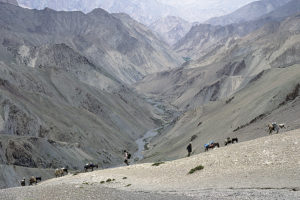
As a rule, the tree limit, as well as the snow limit, of the western area is 300 to 400 m lower than further east. Snowfall is common in Srinagar, Kashmir, whereas it never snows in Kathmandu, which is situated at the same altitude, but 6.5 degrees latitude further south. Not surprisingly, far more species of North Asian and European origin are found in the northwestern region than in the southeastern.
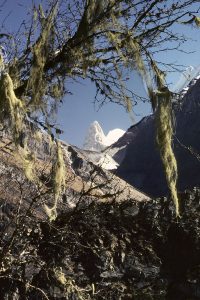
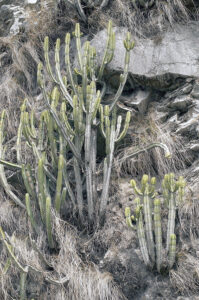
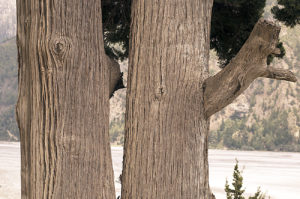
Most of the remaining natural forest is utilized for extensive grazing, and the foliage is lopped of various tree species, also for fodder. Numerous grazing grounds have been established in the upper valleys, utilized between June and September, and the surrounding forests bear the imprint of extensive usage for firewood and timber for temporary huts. Grazing eliminates many plant species, whereas others, especially toxic or spiny ones, benefit from it, including Iris kemaonensis, Anemone rivularis, Astragalus candolleanus, primrose species (Primula), and poppies of the genus Meconopsis.
Many areas are regularly burned to promote growth of grasses for fodder. These fires often spread to the surrounding forest, and certain tree species, such as silver fir, hemlock and cypress, are much harmed by them. Large individuals of chir pine can survive a fire, while young trees are killed. The opposite effect is seen on blue pine. Fires kill older trees, but promote germination of the seeds. In areas with regular fires, large tracts are covered in young forest of blue pine, often with dwarf bamboo beneath. Agriculture benefits numerous weeds, of which many are also found in Europe and North America.
In the major part of the Himalaya, areas with natural vegetation cover steadily decreases, and today, most of the indigenous forest is found in the eastern part of the mountains, especially in Bhutan and the Indian State of Arunachal Pradesh, the former having a forest cover of no less than 70%. Percentage of forest cover decreases gradually, as you go west. Between 1990 and 1995, the forest area in Nepal decreased by one fourth (11,000 km2), and in 1995 the forest cover had reached a low of c. 25%. In Pakistan, the situation is critical. In the Karakoram Mountains, less than 20,000 km2 of forest is left, and this area is diminished year by year.
For thousands of years, local inhabitants of the Himalaya have been utilizing plants for traditional medicine, and collecting these plants is still a very common practice. Several species are seriously threatened by over-collecting, including Sinopodophyllum hexandrum of the barberry family, a species of sagebrush, Artemisia brevifolia, and a composite, Saussurea costus. Some species diminished by 80% in just ten years. An Indian NGO, the Pragya Project, is trying to protect these species through cultivation of seriously threatened species, education of locals, and establishing local groups to promote a sustainable usage of the plants.
Since the 1970s, the magnificent landscapes of the Himalaya have been a much coveted goal for trekkers. Within a few years, numerous tourist groups began camping in the mountains, and local villagers established small hotels, where individual trekkers could eat and sleep.
Especially during the 1980s and 1990s, these thousands of tourists had a significant effect on the vegetation. On average, c. 10 kilos of firewood was used per trekker per day. Naturally, this wood was collected in the surrounding forest, and along the most popular trekking destinations, forests soon bore the stamp of overuse.
In the 1990s, new restrictions were introduced to reduce the effect on the forest. Camping groups must now bring stoves and kerosine for cooking, and individual trekkers are instructed to frequent hotels, which utilize solar energy or hydro-electricity for cooking and for heating water for showers.
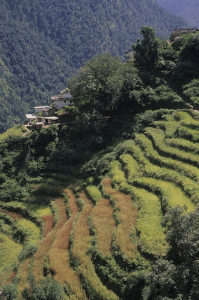

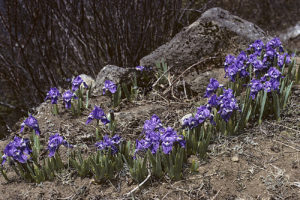
To experience the magnificent flora of the Himalaya, it is often necessary to get away from densely populated areas. As a large part of the mountains are without roads, you must often walk rather long distances to reach the botanically interesting areas. However, a dense network of trails is criss-crossing the mountains, as the locals, for thousands of years, have been transporting goods on the back of porters, horses, mules, or yaks.
In popular tourist destinations, such as Kathmandu and Pokhara in Nepal, Manali in Himachal Pradesh, Leh in Ladakh, and Darjiling in West Bengal, it is possible to hire porters or horsemen to transport tents, cooking equipment, food etc. to areas without hotel facilities.
